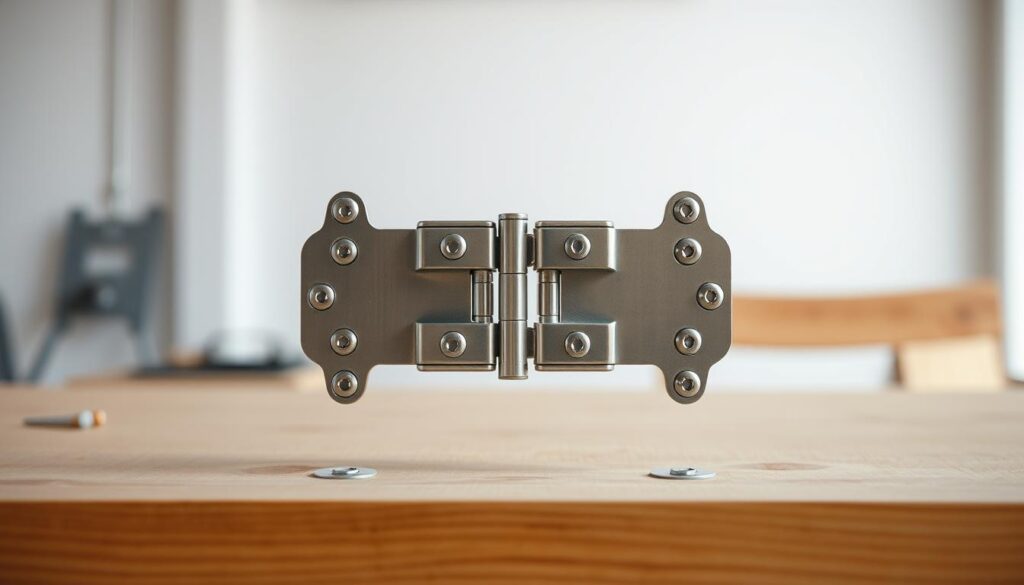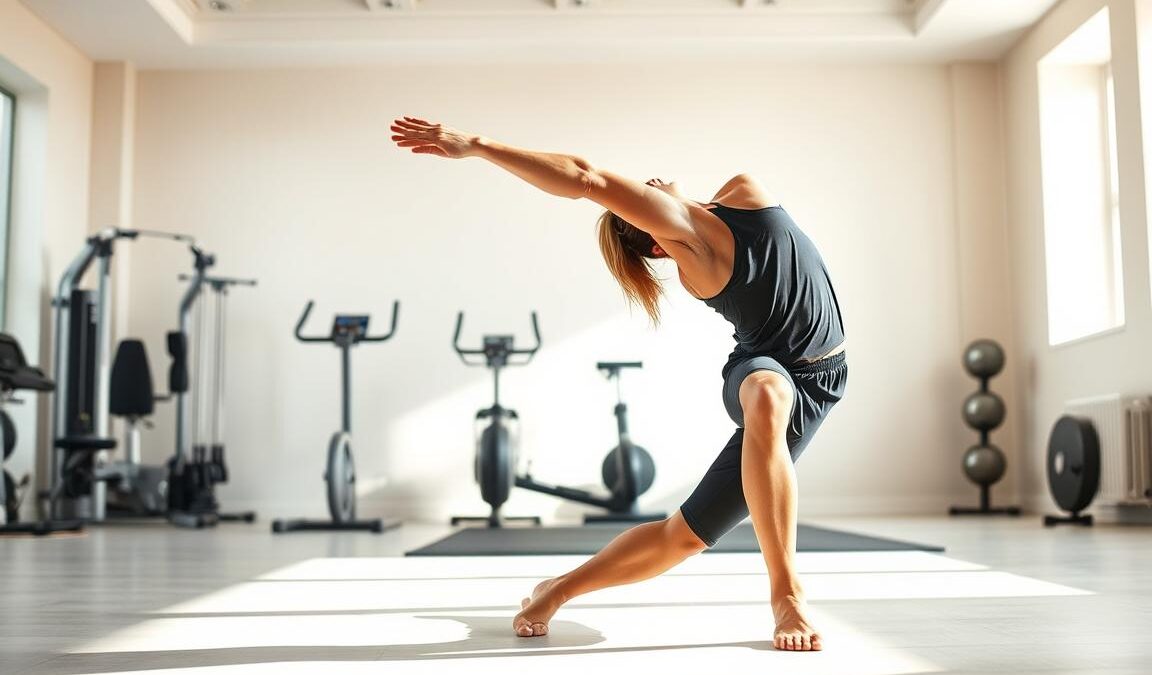
How to Perform the Perfect Hinge Pattern in Lifts
Learning the perfect hinge pattern is key for anyone who lifts. It’s vital for mastering deadlifts and improving daily movements. A good hip hinge enhances your lifting and keeps you safe from injuries.
Ready to unlock your lifting power? Let’s explore the basics of the perfect hinge pattern.
Understanding the Importance of the Hip Hinge
The hip hinge is a key movement for weightlifting. It’s essential for deadlifts, kettlebell swings, and Olympic lifts. By bending at the hips and keeping your spine straight, you boost your lifting power and safety.
Emphasizing the hip hinge improves your lifting mechanics. It enhances your gym performance and daily activities. A strong hip hinge means better support and less injury risk, whether lifting weights or a child.
Using a proper hip hinge protects your lower back from injuries. It lets you lift with more confidence and skill. Learning and practicing the hip hinge can make your workouts more effective and fun.
Key Benefits of Mastering the Perfect Hinge Pattern
Learning the perfect hinge pattern can greatly improve your fitness. It strengthens your posterior chain, which includes your hamstrings, glutes, and lower back. This is key for better performance in lifts, like the deadlift.
Using the right hip hinge technique makes lifting safer. It lowers the risk of injury during workouts and daily activities. Keeping your spine neutral during exercises helps avoid back stress, which is good for injury prevention.
Using the hip hinge in daily life makes tasks like bending safer. It reduces strain and keeps your spine healthy. The benefits of the hip hinge go beyond the gym, showing its value for long-term health. Learn more about preventing injuries and improving your health with this article on injury prevention strategies.
| Benefit | Description |
|---|---|
| Strength Development | Enhances the posterior chain, including hamstrings, glutes, and lower back. |
| Injury Prevention | Reduces injury risk with safer lifting and spine maintenance. |
| Improved Daily Functionality | Makes daily tasks easier and reduces back strain. |
Components of the Hinge Pattern
The hinge pattern has key parts that are vital for its success. Keeping your spine neutral is a must. This helps avoid injuries and boosts the exercise’s benefits. When doing the hinge, let your torso move over your hips while keeping your form right.
Having good hip mobility is also key. It lets you move smoothly and use the right muscles. Without enough mobility, you might strain your lower back.
Staying stable in your lumbar area is also critical. Too much bending in your back can cause injuries. Make sure not to bend your knees too much or flex your back too far. Learning these hinge components helps you do the exercise right, lowering injury risks and boosting strength.
Setting Up for the Perfect Hinge Pattern
Before you start the hip hinge, setting up right is key. Stand with your feet shoulder-width apart. Let your knees bend a bit to help your body stay aligned.
Move your hips back while keeping your upper body straight. This keeps your spine in the right position. It’s also important to engage your core. This helps keep you stable and safe during the lift.
Hold onto your weights tightly. A firm grip helps you control the movement. This way, you can do the hinge correctly and avoid injuries.
By focusing on moving your hips back, you build the power needed. This makes the movement smoother and safer. The right setup is essential for good form and a successful workout.
Here’s a quick checklist for your setup:
- Feet shoulder-width apart
- Knees softened
- Hips pushed back
- Torso upright with neutral spine
- Core engaged
- Secure grip on weights

How to Perform a Proper Hip Hinge
Learning the right way to do a hip hinge is key for safe and effective lifting. It’s important to focus on body positioning, keeping your spine straight, and understanding how the hinge works. These steps help you do the movement right and stay safe from injuries.
Positioning Your Body
Start by placing a dowel rod along your back. Make sure it touches your sacrum, mid-back, and head. This helps keep your spine straight and sets up your body for the hinge.
As you move, your hips should go back while keeping your spine straight. Keep your feet shoulder-width apart and your weight evenly distributed. This makes you more stable.
Maintaining a Neutral Spine
Keeping your spine safe is key for a good hinge. Bend without rounding your back too much. Use your core muscles to keep your spine straight.
Your chest should be up, and your shoulders should be relaxed. Paying attention to your spine is important for a proper hip hinge.
Timing and Movement Mechanics
Getting the timing right is important for a proper hip hinge. Push your hips back while leaning your upper body forward. This creates a hinge at your hips.
This movement helps you stay balanced and prevents injuries. When you go back up, use your glutes and hamstrings to lift. This helps build strength.
| Aspect | Description | Importance |
|---|---|---|
| Body Positioning | Using a dowel rod for alignment | Ensures spine safety and movement accuracy |
| Neutral Spine | Maintaining a straight back | Helps prevent injuries and creates effective leverage |
| Hinge Mechanics | Coordinated hip and upper body movement | Facilitates effective lifting and engages core |
Common Mistakes to Avoid in Your Hinge
Mastering the hip hinge is key. But, it’s easy to make mistakes that can hurt your lifting and spine health. These errors can make your workouts less effective.
One big mistake is overextending your lower back. This puts too much pressure on your spine, raising injury risks. Keep your spine neutral and use your hips and glutes more. Relying too much on your back can cause fatigue and strain.
Another common error is letting your knees bend too much. This messes up the hinge’s motion. Keep your knees over your toes and your hips behind. If your back hurts, it’s time to check your form.
Be careful of these common mistakes. Avoiding them will improve your lifting and performance. For better strength training, check out effective exercises designed for success.
Various Exercises to Reinforce the Hinge Pattern
Learning and practicing the hip hinge pattern is key for lifting well. You can add different exercises to your routine to get stronger. Here are three great options that work on different parts of the hinge pattern.
Barbell Romanian Deadlift
The Romanian deadlift is great for the hip hinge. It helps keep your back muscles tight and improves your form. When you lower the barbell, hinge at your hips, not your knees. This targets your glutes and hamstrings, making it a key exercise for the hip hinge.
Kettlebell Swings
Kettlebell swings can boost your hip hinge skills. They build explosive power and endurance. They teach you to use your hips to generate force, keeping your spine straight. Start the movement with your hips to improve your hinge technique.
Cable Pull-Throughs
Cable pull-throughs are another way to strengthen the hip hinge. They work your back muscles and keep your torso stable. Using a cable machine gives you constant tension, which helps your muscles grow. Keep your core tight and hinge at your hips to practice the movement right.
Progressing to the Perfect Hinge Pattern
Once you’ve got the basics of the hip hinge down, it’s time to get better. You’ll want to add weight and fine-tune your stance. This step will make your lifts more powerful and effective.
Incorporating Resistance
Adding weight can really boost your lifting skills. Start with light weights to keep your form right. Then, slowly add more weight as you get stronger. For better core strength, try using resistance bands. They let you adjust the tension, helping you learn to handle the weight.
Adjusting Form for Advanced Techniques
When you’re ready for more advanced hip hinge moves, your form needs to change. Make sure to engage your core and keep your spine straight, even with more weight. Small tweaks can greatly improve your performance and safety. Pay attention to your knee angle to match your hip movement. These adjustments will help you lift smoother and more effectively.
Who Should Focus on the Hinge Pattern?
The hinge pattern is important for everyone, from top athletes to those who just like to stay fit. It doesn’t matter if you’re new to fitness or have been doing it for years. Learning the hinge can really boost your performance in many areas.
It’s not just for the gym, though. The hinge helps with everyday tasks like bending to tie your shoes or lifting groceries. It teaches you how to move safely and keeps your back healthy. This reduces the chance of injury from simple actions we do every day.
Whether you’re into sports or just want to be healthier, adding the hinge to your routine is smart. It helps you move better and builds strength. It’s a key move that everyone should make a part of their fitness plan.



